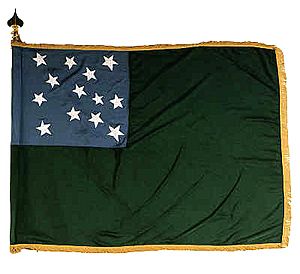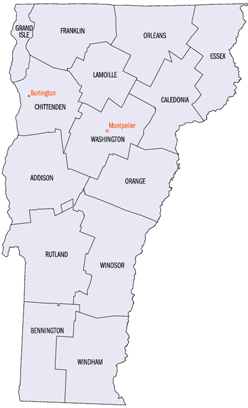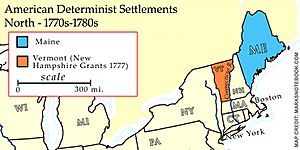New Hampshire Grants facts for kids
The New Hampshire Grants were special land areas given out between 1749 and 1764. These grants were made by Benning Wentworth, who was the colonial governor of New Hampshire at the time. He gave away about 135 land grants, which included 131 towns.
This land was west of the Connecticut River. Both New Hampshire and New York claimed this land. This disagreement eventually led to the creation of the Vermont Republic. Later, this area became the U.S. state of Vermont.
Contents
What Was the Background of the Land Dispute?
The area we now call Vermont was first settled by Europeans when Massachusetts built a fort called Fort Dummer around 1724. This fort was near where Brattleboro is today. Massachusetts claimed land west of the Merrimack River and had settlers ready to move north.
In 1741, the border between Massachusetts and New Hampshire was officially set. This border was 3 miles (4.8 km) north of Pawtucket Falls. This meant Massachusetts no longer claimed land north of that line. However, the land between the Connecticut River and Lake Champlain was also claimed by New York. New York's claim stretched east to the Connecticut River.
Also in 1741, Benning Wentworth became the governor of New Hampshire. He believed New Hampshire's land claims went as far west as Massachusetts's claims did. Since Massachusetts's border went 20 miles (32 km) east of the Hudson River, Wentworth thought the land west of the Connecticut River belonged to New Hampshire. New York, however, based its claim on an old royal document. This document gave Prince James, Duke of York, all lands west of the Connecticut River to Delaware Bay.
How Were the Grants Made?
New Hampshire's Land Grants
Governor Wentworth made his first land grant on January 3, 1749. This grant was for a town called Bennington, located west of the Connecticut River. New York told him to stop, and Wentworth promised to wait for the king's decision. However, by November 1753, New York reported that he was still giving out land in the disputed area.
Grants stopped briefly in 1754 because of the French and Indian War. But in 1755 and 1757, Wentworth had the area surveyed. He then made 108 more grants. These grants stretched 20 miles (32 km) east of the Hudson River and north to the eastern shore of Lake Champlain.
These grants were usually 6 miles (9.6 km) square. This was a standard size for a township. Each grant cost the buyer about £20. The land was then divided among the owners. Six special lots were set aside. One lot was for a missionary group called the Society for the Propagation of the Gospel in Foreign Parts. Another was for the Church of England. One lot was for the first religious leader to settle in the town. One was for a school, and two were for Governor Wentworth himself. There was also a small yearly tax, called a quitrent, of one shilling paid to the king.
New York's Land Claims
While Wentworth was selling land, New York also gave out land patents in the same area. But New York's land patents were often oddly shaped. They were usually given to very rich landowners. The New Hampshire grants, however, were "town-sized" and usually settled by regular farmers.
Most of New York's land boundaries were ignored once Vermont became a state. Some of these New York patents are now called paper towns. This means they only existed on paper and were never actually settled.
What Was the Royal Decision?
In September 1762, New York found New Hampshire surveyors working near Lake Champlain. This made New York's government state its claim again. They referred to their own old land documents and New Hampshire's documents from 1741. In March 1764, Wentworth said that only the king could decide the border dispute. He was sure the king would rule in his favor. He also told his grantees to settle the land and develop it.
New York asked the Board of Trade to confirm their original land grant. This finally settled the border dispute between New York and New Hampshire. On July 26, 1764, the king officially declared the border. It stated that "the Western bank of the Connecticut, from where it enters the province of Massachusetts Bay as far north as the 45th degree of northern latitude, to be the boundary line between the said two provinces of New Hampshire and New York." Wentworth made his last two grants on October 17 of that year: Walker and Waltham.
Why Were the Grants Invalidated?

New York understood the king's decision to mean that all of Wentworth's grants were now invalid. This upset the people living there greatly. New York then divided the territory into four counties: Albany, Charlotte, Cumberland, and Gloucester.
New York demanded that the people give up their original land papers. In many cases, they had to buy their land back from New York at much higher prices. Those who refused to pay lost their legal ownership of the land. New York then gave that land to other people. The settlers, who would later become Vermonters, asked the governor of New York to confirm their New Hampshire Grants. He agreed in part, saying no more grants would be made until the King's wishes were known. Land not previously granted by New Hampshire was open for New York to give out.
In 1770, the New York Supreme Court said that all of Wentworth's grants were invalid. This meant New York officially controlled the region. This made residents very angry, especially Ethan Allen and his group, the Green Mountain Boys. They fought against New York's efforts. The resistance eventually faded, and New York's desire to claim the land also lessened. A bigger issue, the American Revolution, was starting to take center stage.
How Vermont Gained Independence and Became a State
In January 1775, leaders from over twenty towns in the New Hampshire Grants area met in Manchester. They wanted to discuss how to govern themselves, separate from New York. This meeting created a "civil and political Body" to manage their community. Two months later, another meeting in Westminster declared they would not follow New York's government. On March 13, 1775, two men were killed in Westminster by New York officers.
News of the first fights between American militia and British troops at Lexington and Concord interrupted the Westminster meeting. But settlers gathered again at Dorset in 1776. They asked the Continental Congress to recognize Vermont as a state and let its representatives join. However, New York's representatives convinced Congress to say no.
Some former Green Mountain Boys groups fought in the American Revolutionary War. They helped capture Fort Ticonderoga on May 10, 1775. They also took part in the invasion of Canada later that year. Ethan Allen and Seth Warner convinced the Continental Congress to create a "Green Mountain" ranger regiment. Since Congress had no money, they asked New York's government to pay for the new regiment, which it did.
In 1777, the people of Vermont declared their full independence from Great Britain. They also created their own constitution. The first elections under this constitution were held on March 3, 1778. On March 12, the new government was formed in Windsor.
During the later part of the Revolutionary War, some Vermont officials talked with British officials. One of these was Frederick Haldimand, the governor of Quebec. They discussed Vermont possibly rejoining the British side. But in 1781, the main British army surrendered at Yorktown. It became clear that the United States would win its independence.
After the Revolutionary War, Vermont was not allowed to join the new confederation of the 13 former colonies. This was mainly because New York objected. Vermont remained separate until 1791. In 1790, New York finally agreed to Vermont joining the Union. New York gave up its claim to the New Hampshire Grants for 30,000 dollars.
A meeting was held from January 6 to 10, 1791, in Bennington. The goal was to decide about joining the federal Union. The group voted 105 to 2 in favor of becoming a state. Congress approved Vermont's statehood the next month. On March 4, 1791, the New Hampshire Grants, now called Vermont, became the 14th state. It was the first state to join the Union after the Constitution was adopted.
See also
In Spanish: Concesiones de Nuevo Hampshire para niños



